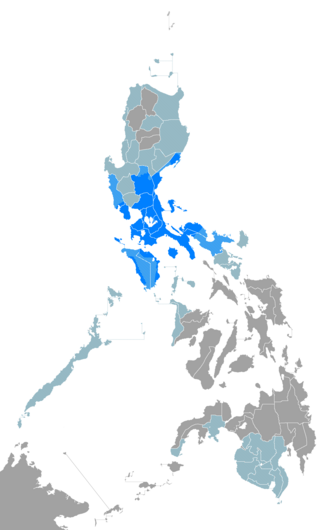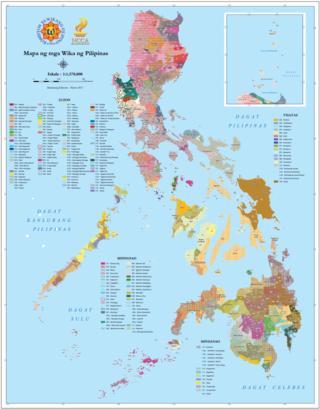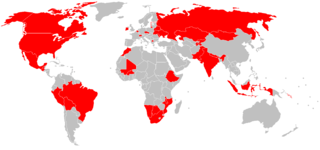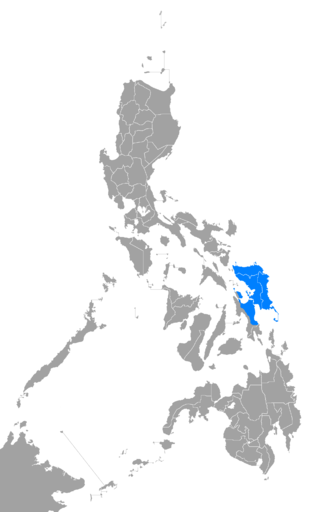
Tagalog is an Austronesian language spoken as a first language by the ethnic Tagalog people, who make up a quarter of the population of the Philippines, and as a second language by the majority. Its standardized form, officially named Filipino, is the national language of the Philippines, and is one of two official languages, alongside English.
Spoken English shows great variation across regions where it is the predominant language. For example, the United Kingdom has the largest variation of accents of any country in the world, and therefore no single "British accent" exists. This article provides an overview of the numerous identifiable variations in pronunciation; such distinctions usually derive from the phonetic inventory of local dialects, as well as from broader differences in the Standard English of different primary-speaking populations.

Of the languages of France, French is the sole official language according to the second article of the French Constitution. French, a Gallo-Romance language, is spoken by nearly the entire population of France.

Education in Singapore is managed by the Ministry of Education (MOE). It controls the development and administration of state schools receiving taxpayers' funding, but also has an advisory and supervisory role in respect of private schools. For both private and state schools, there are variations in the extent of autonomy in their curriculum, scope of taxpayers' aid and funding, tuition burden on the students, and admission policy.

There are some 130 to 195 languages spoken in the Philippines, depending on the method of classification. Almost all are Malayo-Polynesian languages native to the archipelago. A number of Spanish-influenced creole varieties generally called Chavacano along with some local varieties of Chinese are also spoken in certain communities. The 1987 constitution designates Filipino, a standardized version of Tagalog, as the national language and an official language along with English. Filipino is regulated by Komisyon sa Wikang Filipino and serves as a lingua franca used by Filipinos of various ethnolinguistic backgrounds.
A medium of instruction is a language used in teaching. It may or may not be the official language of the country or territory. If the first language of students is different from the official language, it may be used as the medium of instruction for part or all of schooling. Bilingual education or multilingual education may involve the use of more than one language of instruction. UNESCO considers that "providing education in a child's mother tongue is indeed a critical issue". In post-secondary, university and special education settings, content may often be taught in a language that is not spoken in the students' homes. This is referred to as content based learning or content and language integrated learning (CLIL). In situations where the medium of instruction of academic disciplines is English when it is not the students' first language, the phenomenon is referred to as English-medium instruction (EMI).
Official multilingualism is the policy adopted by some states of recognizing multiple languages as official and producing all official documents, and handling all correspondence and official dealings, including court procedure, in these languages. It is distinct from personal multilingualism, the capacity of a person to speak several languages.

Education in Papua New Guinea is managed through nineteen provinces and two district organisational units. It is tuition-free and attendance is not compulsory.
The Singapore-Cambridge General Certificate of Education Ordinary Level is a GCE Ordinary Level examination held annually in Singapore and is jointly conducted by the Ministry of Education (MOE), Singapore Examinations and Assessment Board (SEAB) and the University of Cambridge Local Examinations Syndicate (UCLES).
The Ministry of Education Language Centre is a centralised educational institution for students in Singapore's education system to learn additional languages. There are two campuses located in Bishan and Newton, which are managed by the Ministry of Education of Singapore. Students attend the institution on top of the existing school they are attending.
Public and private schools, colleges, universities, and technical and vocational institutions provide education in the Philippines. Funding for public education comes from the national government. For the academic year 2017–2018, about 83% of K–12 students attended public schools, and about 17% either attended private schools or were home-schooled.
Linguistic rights are the human and civil rights concerning the individual and collective right to choose the language or languages for communication in a private or public atmosphere. Other parameters for analyzing linguistic rights include the degree of territoriality, amount of positivity, orientation in terms of assimilation or maintenance, and overtness.
In South Africa, matriculation is the final year of high school and the qualification received on graduating from high school, and the minimum university entrance requirements. The first formal examination was conducted in South Africa under the University of the Cape of Good Hope in 1858. In general usage, the school-leaving exams, which are government-administered, are known as the "matric exams"; by extension, students in the final year of high school are known as "matriculants" or, more commonly, "matrics". Once the Matric year has been passed, students are said to have "matriculated". See List of secondary education systems by country § South Africa.

The Gusa Regional Science High School - X colloquially RegSci, GSci or RS, is the Regional Science High School for Region X - Northern Mindanao. It is a specialized public science high school supervised by the Department of Education located in Gusa, Cagayan de Oro, Philippines. It is the premier science high school of Northern Mindanao, and one of the two science high schools in the region, together with the Philippine Science High School Central Mindanao Campus. The school was established in 1994 as Gusa National High School - RSHS Annex. It became the Regional Science High School for Northern Mindanao in 2002 through the House Bill No. 3000 of the 15th Congress. From the name Gusa National High School-Regional Science High School Annex, it was then changed into Gusa Regional Science High School - X, through the RA 10267.

Mimaropa Regional Science High School - Bansud National High School, is a public science high school supervised by the Department of Education. It is the Regional Science High School for Mimaropa: Southern Tagalog Islands or collectively known as Mimaropa. It is located in Pag-asa, Bansud, Oriental Mindoro, Philippines with a land area of 30,000 square meters.

Many countries and national censuses currently enumerate or have previously enumerated their populations by languages, native language, home language, level of knowing language or a combination of these characteristics.

Waray is an Austronesian language and the fifth-most-spoken native regional language of the Philippines, native to Eastern Visayas. It is the native language of the Waray people and second language of the Abaknon people of Capul, Northern Samar, and some Cebuano-speaking peoples of western and southern parts of Leyte island. It is the third most spoken language among the Bisayan languages, only behind Cebuano and Hiligaynon.

Ilocano is an Austronesian language spoken in the Philippines, primarily by Ilocano people and as a lingua franca by the Igorot people and also by the native settlers of Cagayan Valley. It is the third most-spoken native language in the country.
The following is a list of bilingual education by country or region.









